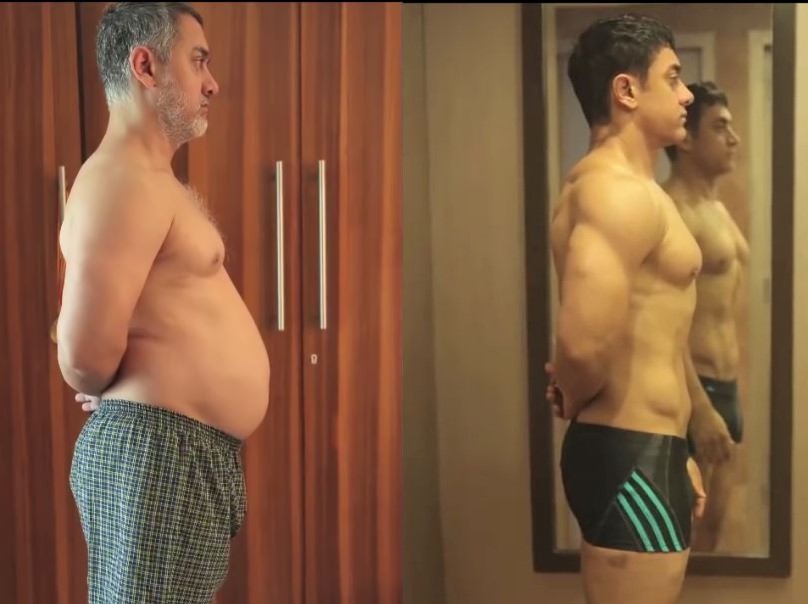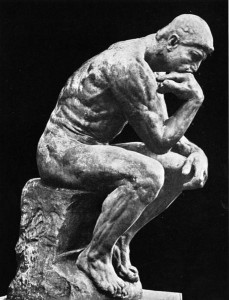
If a normal diet plan doesn’t work for your skinny-fat genetics do you think any random workout program you pulled off the internet will?
You may have tried many routines and exercise programs in the past but did you get the results you wanted? Probably not.
There are a million workout routines out there. Most designed in the West and for Western body types and genetics.
Did you ever consider that maybe these programs were never designed to be used by you?
Remember, as South Asians, we are built differently.
Our training strategy should reflect this.
The Why

Why are we going to add exercise into the mix?
Remember, we are eating to control insulin levels in order to minimize fat storage.
Diet alone will go a long way to improve the way your body handles the food you eat. You will most likely end up eating less which will lead to significant weight/fat loss and a better looking and functioning body.
However, this is only half of the picture.
If we are no longer going to be sending as many of the carbs you eat to your fat cells then where do we send them?
Your muscle of course(and other tissue).
The problem is, South Asians display a high degree of Insulin Resistance in their muscle cells. Meaning the carbohydrates you eat don’t get stored there as much as they should and instead get diverted to your adipose tissue(fat). This is why you have that lower belly fat(men), or you have flabby legs/thighs(women) even at low body fat levels.

We are going to change that.
How?
Strength Training.
This is the stimulus your body needs to change the way it partitions the nutrients you consume (muscle>fat).
But we aren’t going to just pick any of the popular workout programs out there.
We need a plan that takes into account our unique genetic makeup and fixes our disadvantages towards muscle building.
If you don’t care about why most other programs/plans don’t work and just want the workouts then you can skip ahead to the “How” section.
The What

Don’t be like poor Sisyphus
Most strength training plans will not work for South Asian’s, especially beginners, because of the following problems:
- Too much volume (high rep ranges, sets)
- Too high frequency, 4+ days/week
- Are muscle-based rather than movement
- Focus on the wrong muscles/movements
- Focus on Cardio
- Lack of focus on Recovery
- Lack of focus on Mobility
Remember, South Asians typically have https://www.ncbi.nlm.nih.gov/pmc/articles/PMC3405820/ :
- Higher Inflammation levels
- Higher Cortisol levels
- Small wrists
- Fat around the lower chest and belly/hips(men), glutes/thighs(women)
- Difficulty Gaining Muscle
- Sedentary lives
- A low protein diet

Combine these two lists and you have a recipe for disaster.
For example, a typical bodybuilding program geared towards fat-loss looks like this:
High volume workouts, 4+days per week, split into body parts (Chest, Back, Arms, Legs etc.) along with steady state cardio(jogging, elliptical etc.)
Combine this with our naturally high inflammation/cortisol levels and small joints and what you’ll eventually get is:
- Nervous System Fatigue
- Over-training (messed up hormones, energy, performance etc.)
- Joint Pain
- Less muscle mass preserved
Sound like fun?
You’ll end up like poor Sisyphus above, forever spinning his wheels and going nowhere.

Instead, we need a transformation plan that is intelligently designed to:
- Not raise cortisol/inflammation higher than necessary.
- Takes into account our recovery capabilities.
- Targets our weak spots while avoiding certain movements/muscles to balance out our physique (chest, abdomen, legs/hips).
- Focuses on movement quality instead of overloading and muscles.
There are many ways to program this and any good personal trainer/strength coach will be able to figure out 2-3/4 of these points. However, almost none will check all four with a South Asian client.

The following is a sample training program I customize for each client during Phase 1 of the Transformation Plan to fix South Asian/Indian Skinny-Fat Syndrome.
The How
These are the training principles* we will follow in order to avoid over-training, balance our bodies, and build/maintain muscle while losing bodyfat:
- On Upper Body days, no more than 10-12 working sets
- On Lower Body days, 8-10 working sets
- Working/stimulating each muscle group once directly and once indirectly every 7-8 days
- No training to failure, always 1-2 reps in reserve/“left in the tank”, especially with heavy compound lifts
- No Cardio other than walking(to begin with)
- Focus on compound movements with some isolation work
- Avoid Max-effort work(>90% 1 rep max)
- Focus on Upper Back, Upper Chest and Lats to balance physique(for men)

*These principles were hard-won from over a decade of personal experience and experimentation. I have tried nearly every popular protocol out there so that you don’t have to and I have found by adhering to these principles, I was able to maximize my muscle growth, balance my body and obtain optimal results. Furthermore, they are also adapted from many other renowned coaches1http://johnalvino.com/skinny-fat-solution/https://anthonymychal.com/11-training-tips-for-the-skinny-fat-ectomorph-revisited/ who have transformed many skinny-fat clients (albeit not South Asian/Indian).
The Protocols
Whether you are brand new to strength training or have some experience, this is routine I recommend* for the first 4-6 weeks:
Day 1 – Horizontal Push/Pull
| Exercise | Sets | Reps |
| DB Low Incline(15-30°) Bench Press | 3 | 8-12 |
| DB Single Arm Row | 3 | 8-12 |
| DB Curls | 3 | 8-12 |
| Band Pull-Apart Pronated grip | 3 | 8-12 |
Day 2 – Lower Body (Posterior focus)
| Exercise | Sets | Reps |
| Deadlift (or regression) | 3 | 8-12 |
| Goblet Squat | 3 | 8-12 |
| Calf Raises | 2 | 15-20 |
| Ab Circuit, 2-4 exercises back to back | 2 | 10-20 |
Day 3 – Vertical Push/Pull
| Exercise | Sets | Reps |
| DB Neutral Grip OH Press | 3 | 8-12 |
| Chinup/Partial Chinup/Negatives | 3 | 5-8 |
| DB Upright Row or Lateral Flyes | 3 | 8-12 |
| Bench Dips | 3 | 8-15 |
Day 4 – Lower Body (Anterior focus)
| Exercise | Sets | Reps |
| Front/Back Squat (or regression) | 3 | 8-10 |
| Romanian/partial Deadlift | 3 | 8-10 |
| Seated Calf Raise | 2 | 15-20 |
| Hanging Leg/Knee Raises with slight posterior pelvic tilt | 2 | 10-15 |
Legend: DB = Dumbbell, KB = Kettlebell, BB = Barbell, OH = Overhead

Spacing/Schedule
The workouts should be done 2-3x/week for beginners and 3-4x/week for more experienced lifters. These days can be spaced apart as follows:
3 days(2-week sample):
| Day 1 | off | Day 2 | off | Day 3 | off | off |
| Day 4 | off | Day 1 | off | Day 2 | off | off |
and so forth.
4 days:
| Day 1 | Day 2 | off | Day 3 | off | Day 4 | off |
or
| Day 1 | off | Day 2 | off | Day 3 | Day 4 | off |
*Obviously this is a sample training split and for optimal results, this would be further customized to each client. However, it is a great plan to get started.
Notes:
If any of these exercises sound unfamiliar, or you need warmup suggestions Google them!
There are plenty of free resources (videos/articles) out there that will teach you how to correctly perform each movement and avoid injury while doing so.
Feel free to design your own workout program based on most or all of the principles above.
Conclusion

(They taught me all I knew);
Their names are What and Why and When
And How and Where and Who – Just So Stories, Kipling
We’ve now covered the Why, What and How of our Strength Training Plan. All that’s left is the Who, When and Where. The first two elements would be further customized to the individual and are beyond the scope of this article (see my upcoming ecourse or online coaching). However, I have intentionally generalized for South Asians as a whole and provided a plan that is far more customized than any other program on the internet or from your local trainer.
As for the Where?
Get to the Gym and see for yourself.
Yours,
Gurneet
Share, Comment, Subscribe.


I get what you mean, but if I don’t do reps to failure, I don’t move up in weight numbers for lifts. What I’ve done so far is just bulk/cut cycles. I have a good physique, but my numbers themselves have always been low (170 lbs, B: 190, S: 245, DL: 285). I have hope for improving the last two, and mild hope for improving the first one on my current bulk.
Why do you say no cardio? Don’t you need some sort of control over your metabolism as you’re building muscle? Also you need some cardio (HIIT training) during a cut. I’m curious to know if you strongly feel like cardio just got in the way.
Hi John,
Thanks for your comment.
Failure is not required to move your numbers up. It can be used as a tool strategically to do so but it is far from the only way. For example if on week 1 you do 245lbsx5reps for bench and leave 1 rep in reserve and do 245lbsx5 the next week but with a faster rep speed or with less effort required, it is almost certain your 1 rep max increased and you did not train to failure. Not only that but you will require less recovery in-between since you did not fatigue your CNS(Central Nervous System) as much and will also likely be at less risk of injury.*
I do not know what you mean by “control over your metabolism”, whatever you mean resistance training is more than enough. Muscle building is just stimulus from resistance training in addition to the resources required to build it (ie. rest, food), typically in a caloric surplus for most. If you are getting enough stimulus from resistance training and are eating slightly more calories than you burn, you will gain mostly muscle. Cardio(best case) will just increase energy expenditure and you will have to eat more to make up for it. Worst case, it will impede recovery by reducing the signal to noise ratio(body confused, should I store more energy or lose it) for growth in addition to taking away precious calories needed for building muscle, not to mention make you feel worse(low energy). HIIT cardio will have less of a bad effect but is not at all necessary. I like to include it only when necessary to boost fat loss/calorie expenditure. The only cardio I universally recommend in a fat loss phase is walking.
*Note: This article is more about body composition and not about as much about strength so lifting numbers aren’t a big focus, especially during a fat loss phase.
G
This depends on the ethnic groups within south asia
Pakistani western types like Azad Kashmiris and Pashtuns and Baloch have been found to have 57 kg lean mass at start before working out
Indeed however those are smaller minority groups who’s diet and ancestry is slightly different than that of the general population (more meat for Pakistani’s/muslims for example). They are located near the edges of whats defined as South Asia (more turkic genes) and typically in different climates/environments (even Kashmiri Pundit’s diet varies as they live in mountainous terrain and eat more fatty meat compared to the rest of India and more often lack the skinny fat physique).
Any way to get your e book or contact you..I fit all the categories above..have worked our diligently for 15 years..with the only thing being injuries , many of them , no muscle improvement and a hernia to add as well .but I still carry on :).. pretty hopelessly though
Hi Shrey,
Yes there is a contact page in the menu, but since I have your email I will send you a consultation form for new clients and we can book a time from there. Thanks for reaching out and I am sure I will be able to help.
Best,
Gurneet
Can you provide a body weight training plan? Due to covid 19 all the gyms in my state are closed and I was wondering what body weight plan is best for us
Hey Ranjit,
Yes I could and I may work on that in a future article. Thanks for the suggestion.
I have provided customized home workouts for most of my coaching client’s but will try to upload a general one here.
In the meantime I would checkout Alexander Cortes’s free body weight home workouts at https://gumroad.com/alexanderjacortes?maxPrice=0
Or anything by Al Kavadlo such as his book Pushing the Limits.
Best,
Gurneet
What are your thoughts on strong lifts 5×5?
Nothing special
Would a high rep calisthenic workout plan also cause high inflammation and high cortisol levels or would it be better for south indians since its low impact?
Probably not since if its high rep its low load but could conceivably if you are training with a lot of volume, especially hard on connective tissue. Most importantly high reps will have highly diminished returns in terms of performance gains and body composition. Need to challenge with more advanced variations (ie. planche pushups) and keep progressing while reps stay low-moderate with lots of rest.
What would be best diet plan?
Whatbis the optimal time required for small recompositions to start showing ? 4 months enough ?
Depends on your starting point and recomposition strategy, if you are an absolute beginner/no weight training experience you should definitely see some results no matter the strategy. If you are experienced and at maintenance you may be stronger at the same body weight but hard to tell visually. If you are at a deficit you will notice.
So what do you do after the first 4-6 weeks?
If your gains plateau or you want to work on different areas switch up your training program! Otherwise can keep going with the same exercises!
Doesn’t limiting volume and avoiding max effort limit the potential for size/strength gains? If so, is a “decent” physique our upper limit or is a “holy sh*t” physique possible?
Not really. Even then you should periodize, these recc.s are primarily for beginners and those in a fat loss phase, based on your goals or during a gaining phase you can increase volume and training intensity
Here is an easy to understand summary:
https://www.youtube.com/watch?v=ekQxEEjYLDI&ab_channel=JeffNippard
https://www.youtube.com/watch?v=deDlhPmT2SY&ab_channel=JeffNippard
-G
How can I contact you? I have the typical south asian bod (Pakistani) and keen to jump on a plan.
Hi Rashid, you can signup at transform.southasianstrong.com to get your transformation started with our all new transformation program.
Best,
G